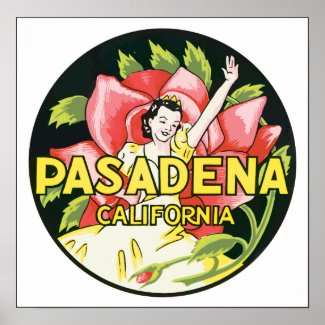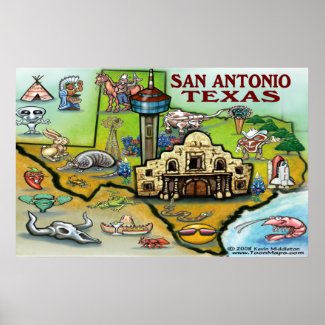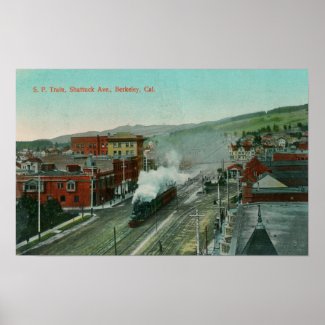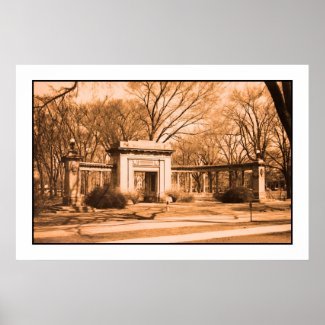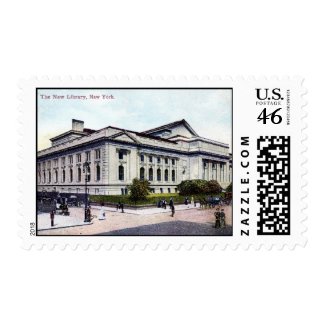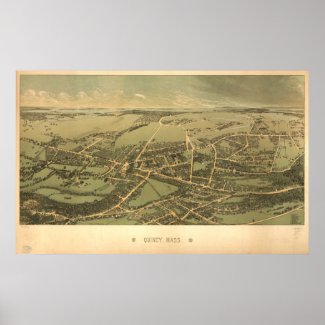This blog represents a collection of postcards that focuses on libraries in the United States and throughout the world.
Wednesday, February 29, 2012
1906 Carnegie Free Library, Streator, Illinois
[LIB6456] - The Streator Public Library was made possible with a $35,000 a grant from Andrew Carnegie. With its two-story high domed ceiling, Ionic columns and oak staircases, it was considered too extravagant by critics when it opened in 1903. The Library was added to the National Register of Historic Places in 1996. [Wikipedia]
Library, Wheaton College, Wheaton, Illinois
[LIB6455] - Completed in 1975, the Library houses learning resources in an attractive setting for the pursuit of academic excellence which characterizes life at Wheaton College. Total book capacity, including adjacent Nicholas Building (renovated previous library in left foreground) is 217,535 volumes. Current holdings total 160,000. Seating capacity of both buildings is 683. [From the back of the card]
Public Library, Hastings, Nebraska
[LIB6454] - Constructed in 1963 at a cost of $415,000. It contains over 53,000 volumes. [From the back of the card]
Public Library, Pasadena, California
[LIB6453] - The library pictured on this postcard was located at 285 East Walnut Street, Pasadena. Pasadena's Central Library was designed by the firm of Myron Hunt and H.C. Chambers, the architects of the Huntington Library and Occidental College. The Pasadena Central Library is on the National Register of Historic Places, and has been the location for several major motion pictures. The facility is visited by an average of more than 55,000 people each month.
Entrance to the Alamo Library, San Antonio, Texas
[LIB6452]
1948 Entrance to Memorial Library, Goshen College, Goshen, Indiana
Tuesday, February 28, 2012
Public Library, Mystic, Connecticut
[LIB6450] - In 1891, Captain Elihu Spicer of Mystic and Brooklyn, N.Y. announced that he planned to build a library on the corner of West Main and Elm Streets for the communities of Mystic and Noank. The building would be two stories with a library, complete with a book collection on the second floor, and a large public meeting room on the first floor. [Read more of the history of this library here]
1907 Carnegie Library, Allegheny, Pennsylvania
[LIB6449] - The Pittsburgh library was not, however, to become the first municipally owned and operated "Carnegie Library." That distinction went to the then independent City of Allegheny, now Pittsburgh's North Side. It was legally empowered to accept Mr. Carnegie's offer of May 29, 1886, at once, and work on the building began September 12, 1887. It was formally opened February 20, 1890, and was known as the Carnegie Free Library of Allegheny. [Read a comprehensive history of this library here]
1905 Carnegie Library, Allegheny, Pennsylvania
[LIB6448] - The establishment of the Carnegie Library of Pittsburgh was forecast in a letter, November 25, 1881, from Andrew Carnegie to the Mayor of Pittsburgh in which Mr. Carnegie offered to donate $250,000 for a free library, provided the City would agree to provide the land and appropriate $15,000 annually for its maintenance. This offer could not be accepted, because at that time Pittsburgh was not authorized to expend funds to maintain a public library. [Read an extensive history of this library here]
Tuesday, February 21, 2012
Public Library, Berkeley, California
[LIB6442] - It is often forgotten that Berkeley had a Carnegie library from 1903 until 1929. Designed by John Galen Howard, founder of the School of Architecture at the University of California and architect of some of the early notable campus buildings, it was located in the garden of the Shattuck Estate at Shattuck and Kittredge streets, on land donated by Mrs. Francis Shattuck whose husband had served as president of Berkeley's first Board of Library Trustees. Berkeley's first public library in 1892 was the effort of three recent University graduates and named for Oliver Wendell Holmes. The WCTU contributed additional books and in 1895 letters from school children convinced the city to provide tax support. A $40,000 Carnegie grant was received in 1903. That library was soon outgrown and requests for further Carnegie funding were denied. Three branches were built before the Carnegie was demolished, the first California Carnegie to meet that fate. Its more famous successor as Berkeley Public Library is listed on the National Register of Historic Places. [From the website]
1906 Public Library, Farmington, Maine
[LIB6441] - In 1799, shortly after the Town of Farmington was incorporated (1794), a small group of residents organized a Social Library which circulated books until disbanding in 1856. There followed a few unsuccessful efforts at forming a library, and in 1890 the current Farmington Public Library Association was incorporated and is continuing to serve the community and the region. [From the website]
Original building still in use.
Free Public Library, El Paso, Texas
Smaller Servings for Libraries
The percentage of university funds allocated to academic libraries shrank for the 14th straight year in 2009, dipping below 2 percent for the first time, according to updated figures from the Association of Research Libraries.
Read more: Inside Higher Ed
1909 Carnegie Library, Oberlin, Ohio
[LIB6439] - Carnegie Library, the gift of Mr. Andrew Carnegie, of New York, is located at the northeast corner of Professor and Lorain Streets. The building is constructed of Amherst sandstone; its dimensions are 135 by 110 feet. Messers, Patton and Miller, of Chicago, were the architects, and the building was constructed by Mr. George Feick, of Sandusky, Ohio. The total cost was $155,600 of which amount Mr. Carnegie furnished $150,000. The construction of the Carnegie Library was commenced in May, 1907, and the building was dedicated June 23, 1908, in connection with the celebration of the Seventy-fifty Anniversary of the College. [From the Oberlin College Archives]
Labels:
Carnegie library,
Oberlin,
Oberlin College,
ohio
1934 Public Library, Edgerton, Wisconsin
[LIB6438] - In Jan., 1907, Edgerton opened a beautiful neoclassical revival style brick and stone Carnegie building with 2400 books and a spacious reading room with oak furnishings and community space in the lower level. Two fireplaces were there for comfort and beauty. Community suppers, meetings and plays were held there. It was a delight for our community. We still have that building, and it has changed over the years without losing its architectural character or being enlarged. Children gather in the former Culton Hall for programs and services. Computers and many books now occupy much of the formerly spacious reading room. Time has brought change. In 2003, the library has a collection of more than 32,000 books, magazines, video recordings, audio recordings, and historical materials. In 2002 it circulated more than 71,000 books, videos, books on tape, magazines and other items. [From the website]
The original building is still being used as a library.
1912 Library, Norwalk, Connecticut
[LIB6437] - Though Norwalk was second to South Norwalk in founding a public library it was the first to get a building from Carnegie funds. As its rental rooms were inadequate, in 1901 the library applied for a Carnegie grant. Steel magnate Andrew Carnegie, a great supporter of public libraries, gave money for a library building to any town or city that would promise to continue funding the library at an annual rate equaling 10% of the building grant. The City agreed to provide funding, and Norwalk received a grant for $20,000. The size of the Carnegie grant was a function of the population served by the library. Norwalk and South Norwalk were both very small cities at the time, each having a population of about 10,000. [From the website]
Monday, February 20, 2012
Public Library, Livermore, California
[LIB6436] - The Classical Revival Livermore Carnegie building is an example of the library as "temple in the park." It is located in the center of Carnegie Park, between Third and Fourth, J and K streets. William Weeks incorporated numerous classical elements in his design of the library with its pedimented central portico supported by Greek Ionic columns. The building is on a raised site reached by steps rising in two tiers. A fountain and a pair of iron light standards mark the entrance. As part of its 1977 centennial, Livermore undertook exterior restoration of the building and it was designated a local landmark by the City Council in 1987.
The Livermore library traces its history to the Livermore Public Library Association of 1878 and later the men's Social Club and the Ladies' League of Progress. It became a public library in 1901. Carnegie funds were requested in 1908 and $10,000 was granted in 1909. Community performances, shows, and a ball raised funds to develop the park site. The building's distinctive yellow brick came from the nearby Carnegie Brick Works, apparently named earlier in admiration for the industrialist. Hoyt Bros. of Santa Rosa built the library. Public outcry succeeded in saving the building after the new library was built and it now houses the Heritage Guild History Center, a genealogical library, and the Livermore Art Association. [From the website]
1910 Carnegie Library, Livermore, California
[LIB6435] - In 1909, the Livermore Free Library applied to Andrew Carnegie for a grant to enlarge the
Library. The grant was approved in October of that year and a site between Third and Fourth Streets and
J and K Streets was chosen for the new building. The new Library formally opened in May, 1911, and
remained in operation at that site until 1966. [From the website]
Library, Stanford University, Stanford, California
[LIB6432] Website
Library, Riverside, California
[LIB6431] 1902 Construction begins on the downtown library at the northeast corner of Seventh and Orange Streets. The Mission Revival building is the work of the architectural firm of Burham and Blieser of Los Angeles; the general contractor is J. W. Carroll of Riverside.
31 July 1903 The Carnegie Library opens to the public. It has a capacity of 20,000 volumes.
November–December 1964
The Carnegie Library and the Allatt and Humphrey Houses are demolished; the new downtown library is occupied and opened to the public.[From the website]
Carnegie Library, Belmar, New Jersey
[LIB6430] - On August 11th 1911 a group of ladies met at the home of Miss Louis Phillips. She and her friends were greatly interested in giving to young people the highly organized activities that could be obtained through a Public Library. With this goal in mind the ladies got together and opened the First Belmar Library on September 23rd 1911.
During the first year the library grew so rapidly that on May 1st 1912 it had to be moved to a larger building. As interest became greater it finally was decided that even this space was too small.
The Belmar Public Library as it now stands was opened to the public on December 4th 1914. The building is Colonial in style and Edward Tilton of New York was the architect.
The plans for the Library were thought to be so excellent by the Carnegie Corporation that they adopted them as the standard for future libraries all over the Country.
In 1935 a portrait of Andrew Carnegie was presented to the Library by the Carnegie Corporation. It is a copy of the portrait painted by Luis Mora. One was given to each of the Carnegie Libraries in the Centennial.
—”Belmar In Retrospect” by Grace Trott Roper [From the website]
Wednesday, February 15, 2012
Morse Library, Beloit College, Beloit, Wisconsin
[LIB6428] - The Colonel Robert H. Morse Library - Richard Black Information Center was built in 1961 and renovated in 1991. The library's collections include 240,000 books. [From the website]
Labels:
Beloit,
Beloit College,
Morse Library,
Wisconsin
Thomas Crane Public Library, Quincy, Massachusetts
[LIB6427] - The Thomas Crane Public Library was built in four stages: the original building (1882) by architect H. H. Richardson; an additional ell with stack space and stained glass (1908) by William Martin Aiken in Richardson's style; a major expansion (1939) by architects Paul A. and Carroll Coletti, with stone carvings by sculptor Joseph A. Coletti of Quincy; and a recent addition (2001) by Boston architects Childs, Bertman, and Tseckares, which doubled the size of the library. [Wikipedia]
Labels:
massachusetts,
Quincy,
Thomas Crane Public Library
Francis Harvey Green Library, West Chester State College, West Chester, Pennsylvania
[LIB6426] - Built in 1902, remodeled in 1938-1941, dedicated in 1947 to Dr. Francis Harvey Green, former chairman of the English Department.
The library has a valuable collection of rare books on natural history, the four folios of Shakespeare's plays (1623-1685) and the Sanderson Biographies of the Signers of the Declaration of Independence, with autographs of the signers. [From the back of the card]
Sawyer Library, Williams College, Williamstown, Massachusetts
[LIB6425] - Sawyer Library is named after the 11th President of Williams College, John Edward Sawyer. Sawyer is the main campus library and houses collections that support the arts, humanities, and social sciences. The collections also include most of the library systems' government documents, videocassettes, and sound recordings. [From the website]
Labels:
massachusetts,
Sawyer Library,
Williams College,
Williamstown
Wednesday, February 8, 2012
Feeney Memorial Library, Mount St. Scholastica College, Atchison, Kansas
[LIB6424] - The Benedictine College Library supports the College’s mission to educate men and women within a community of faith and scholarship. Our primary task is to serve the educational and research needs of our main constituencies, the faculty, students and staff of Benedictine College and the monastic communities of Saint Benedict’s Abbey and Mount St. Scholastica Monastery. Through resource sharing and cooperative agreements, the Library’s collections are accessible to the greater Atchison community and the world at large. As heirs to 1500 years of Benedictine tradition, we are committed to preserving, expanding and making available our historical and contemporary collections in various formats. Website
John Preston McConnell Library, Radford College, Radford, Virginia
[LIB6423] - Dr. John Preston McConnell was born in Scott County, Virginia. Before serving as Radford University's first president from 1911–1937, McConnell had served for nine years as education and professor of history and economics at Emory and Henry College. [Wikipedia]
Public Library, Mason City, Iowa
[LIB6422] - Mason City’s first library started in 1871 and was not a free public service but rather a subscription library. Only paid subscribers were allowed to borrow books. The project did not last very long and in 1888, a second library opened as a reading room. That ended when, in 1892, the city’s voters decided to levy a one mill tax on property to support a free public library. [Read more of the history of this library here]
A Patton and Miller design, this library was dedicated on January 10, 1905, but by 1940 a new library was opened. It now houses private businesses. [Wikipedia]
Library, Birmingham Southern College, Birmingham, Alabama
Labels:
alabama,
Birmingham,
Birmingham Southern College
Tuesday, February 7, 2012
Memorial Library, Cooper Park, Liberal, Kansas
[LIB6420] - Located on US Highways 54 and 83 has the World's Largest Book, its Book Front Entrance, and statues: "Goddess of Liberty" and "Pioneer Mother." [From the back of the card]
1955 Public Library, Rock Hill, South Carolina
[LIB6419] - Conveniently located. The library is thoroughly modern in every detail. About 20,000 volumes.
The Public Library, Vineland, New Jersey
[LIB6418] - Erected in 1904, Andrew Carnegie donated $12,000 and the citizens of Vineland donated the land on which the building is erected and $2500. [From the back of the card]
1944 Carnegie Public Library, Centralia, Illinois
15 Amazing Effects of Prison Libraries - Best Colleges Online
Article forwarded to me by Tim Handorf. Talk about the transforming power of libraries! 15 Amazing Effects of Prison Libraries - Best Colleges Online
Monday, February 6, 2012
1938 Library, Kokomo, Indiana
[LIB6410] - Resources of the Genealogy and Local History Department include microfilm, vertical files, periodicals, maps, and over 12,000 books including over 550 family histories. Collection emphasis is on Indiana's 92 counties, particularly Howard County and the adjacent counties of Carroll, Cass, Clinton, Grant, Tipton, and Miami. Research materials for states from which settlers migrated to Indiana and many general genealogy reference resources are available as well. Visit the Library website!
Library, Mill Village, New Hampshire
[LIB6409] - Known as the Olive G. Pettis Memorial Library [Website]. The library was established in 1890. Ms. Pettis was a local author of religious books.
1910 Birchard Library, Fremont, Ohio
[LIB6408] - On June 3, 1874, Birchard Library opened its doors to the public in a building on Front Street. Containing 1,683 volumes of the 5,000 books ordered by Hayes, patrons could borrow books only if they were 14 years or older and deposited a bond or $3.00. Only librarians could remove books from the shelves. [Read more at the website]
1922 Public Library, Painesville, Ohio
[LIB6407] - The nucleus of the Morley Library on Phelps Street was provided by the local Women's Christian Temperance Union, which established a temperance library and reading room in 1878. After librarian Mary Dean's death in 1898, friends set about fulfilling her dream of a free public library. Other groups donated more books, the Village of Painesville agreed to provide tax funds, and businessman Jesse Healy Morley bought the land and erected the building. It was named in honor of his parents. Morley Library opened its doors in October, 1899, with Julia Erwin as librarian. [More at the website]
A new library was dedicated in 2004. Note the card has the location of this library as 'Painsville.'
1948 Coram Library, Bates College, Lewiston, Maine
[LIB6406] - 1902 Coram Library opens. The library books are transferred from Hathorn by hand-cart over a wooden track stretching from Hathorn to Coram. There are 20,972 volumes in the collection. Estimated cost of building and equipment is $51,000. The library extends its hours and opens Saturday evenings for the first time. [Read more at the website]
Subscribe to:
Posts (Atom)







